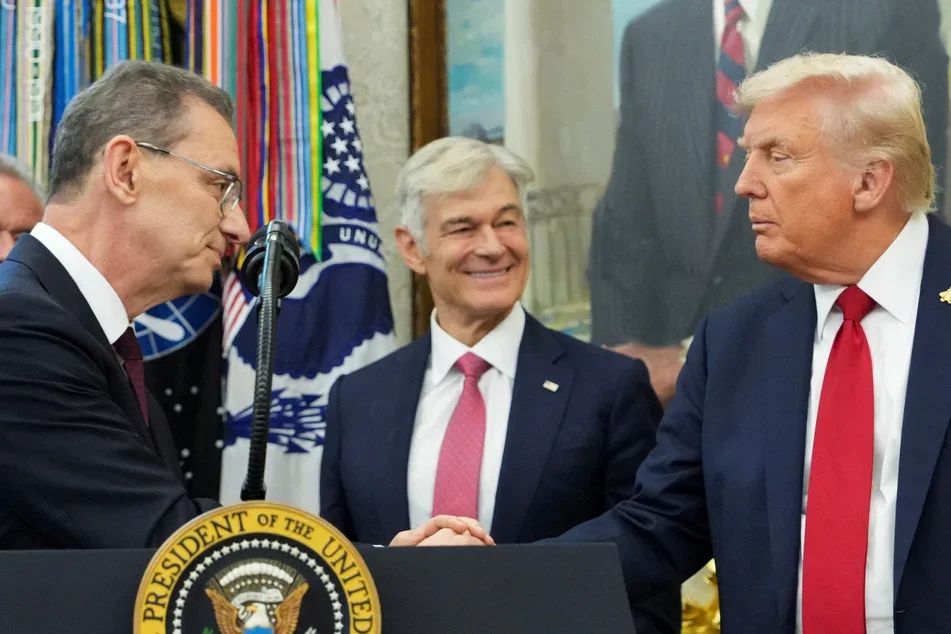TrumpRx — Affordable Medication at Last?
TrumpRx — Affordable Medication at Last?
The effects of Trump’s power play with the pharmaceutical industry are yet to be seen.
(President Donald Trump shakes hands with Pfizer CEO Albert Bourla.| SOURCE: Reuters)
On September 30th, 2025, President Trump upended the entire pharmaceutical industry by unveiling a groundbreaking agreement with major company Pfizer to sell drugs and medicine directly to patients at lower prices rather than through insurance.
The discounted medicine will be available on a federal government-operated website called TrumpRx by 2026. FDA commissioner Dr. Marty Makary described the deal as a “major step” in helping American patients afford pharmaceuticals. Until now, Trump has been unsuccessful in breaking deals with big drugmakers.
Although it is not clear whether TrumpRx will assist Americans covered by private insurance, the website would allow patients to pay cash directly for selected drugs at reduced prices. According to a Pfizer press release, the direct-to-consumer prices for pharmaceuticals on TrumpRx will be 50 percent lower than the national average.
The deal is the Trump administration’s biggest victory on drug pricing negotiations. Since May, the President has pressured large pharmaceutical companies to lower prices for American patients.
High prescription drug prices have been a pressing issue for Americans long before the second Trump administration. A report from Reuters found that median annual list prices for new pharmaceuticals more than doubled from 2021 to 2024, going from $180,000 to $370,000.
Even as the government attempted to bring down prescription costs, prices still increased, becoming a burden to patients nationwide. According to a 2024 study from Rand, American prescription drug prices were on average 2.78% higher than in 33 other OECD countries. A 2024 survey not only reported that many Americans found current costs to be unreasonable, but also that the federal government should be doing more to regulate prices. The results revealed a near bipartisan consensus, with 82% of Democrats and 68% of Republicans desiring more federal regulation.
The Biden administration made efforts to address the issue through signing the Inflation Reduction Act, which allowed Medicare to negotiate drug prices and crack down on above-inflation price increases. However, non-Medicare recipients were still heavily burdened.
President Trump re-entered the White House determined to lower prescription drug prices, albeit more forcefully than his predecessor. On May 12, 2025, the President signed an executive order giving pharmaceutical companies 30 days to lower costs.
It was in line with his “most-favored nation” approach to lowering drug prices, an approach that was implemented during the final weeks of his first term.
In August, President Trump sent letters to 17 pharmaceutical companies, demanding most-favored nation pricing. The deadline was September 29. Four days before the deadline, Trump threatened 100% tariffs on branded drug imports, unless the companies caved in to pricing demands.
Then, on September 30, an agreement was reached. According to President Trump, Pfizer agreed to follow most-favored nation pricing and “offer all of their prescription medications to Medicaid.”
Pfizer announced it would invest $70 billion in R&D, infrastructure, and capital investments in the United States over the coming years. In exchange, Pfizer would be given a three-year deferment during which it would be protected from all pharmaceutical tariffs.
Pfizer became the first major pharmaceutical company to make a deal with Trump. Other companies could follow Pfizer’s example.
With discounts averaging 50 percent on TrumpRx, Pfizer puts itself in a risky situation regarding revenue. However, increased sales thanks to direct-to-consumer access could offset the lower prices. Additionally, long-term exposure to tariffs could have meant a severe reduction of revenue in the United States. During the three-year relief window, Pfizer is expected to onshore rapidly, creating job opportunities and new American drug-manufacturing facilities. With investment into the country and political goodwill being a far better alternative than the financial implications of 100% tariffs, Pfizer took the safe option.
The exact specifics of the Pfizer agreement are yet to be seen. What counts as an “investment” by Pfizer isn’t detailed. It’s unknown how long the agreement will hold, or what the penalty is if one side doesn’t deliver on its terms.
However, the deal is a significant victory for the Trump administration and could vindicate the idea that tariffs brandished as a weapon yield results.


